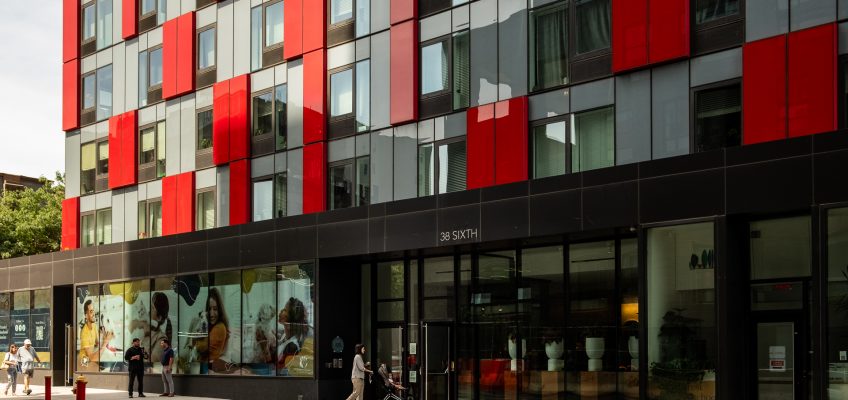“The city must guarantee family-sized units by ensuring that at least 20 percent of Housing Connect apartments are three-bedrooms or larger,” the author writes. “It must align ‘affordable’ rents with voucher standards so that developers receiving subsidies cannot set prices above Section 8 limits.”
A building with income-restricted apartments in Brooklyn. (Adi Talwar/City Limits)
With a mayoral election and City Council races on the horizon, New York’s leaders are promising bold action on affordability. But for families like mine, the housing system is already broken.
In New York City, one of the most common ways to pursue a highly coveted “affordable apartment” is through the Housing Connect lottery. Like many New Yorkers, I check the listings regularly, hoping to find something that fits my household of six. With my Housing Choice Voucher in hand, the process should be straightforward: apply as a working family with rental assistance, and finally secure stability.
After months of checking, I found a listing that seemed like the perfect fit—a three-bedroom apartment near my children’s schools. On paper, it should have worked. Instead, I was rejected because the rent was higher than my voucher allowed.
I appealed, as the system instructs families to do. I explained why the decision should be reconsidered, submitted the documents, and waited. Months later, I am still waiting.
This silence reveals a deeper truth: for larger households, the “choice” in the Housing Choice Voucher program is often an illusion—a mirage that families are told to chase but can never reach.
The first barrier is supply. Families like mine are required to rent three-bedroom or larger apartments, yet these units are exceedingly rare. According to the New York City Independent Budget Office, only about 8 to 10 percent of Housing Connect listings are three-bedroom units, and four-bedrooms are almost nonexistent.
Meanwhile, City Limits reported that New York lost over 23,000 four-bedroom apartments between 2010 and 2017, even as thousands of smaller units were added. This means large households are left competing for a sliver of the city’s affordable housing stock.
Even when a three-bedroom apartment appears, affordability remains out of reach. As of July 1, 2025, the standard Section 8 payment for a newly leased three-bedroom in Brooklyn is $3,811. Yet Housing Connect “affordable” three-bedrooms in high-opportunity neighborhoods—communities with strong schools, safe parks, and access to jobs—are often priced at $4,000 or more.
Developers receiving subsidies and tax breaks can set rents above voucher limits. While landlords can negotiate rents down to match what vouchers will cover, this rarely happens. Families with vouchers are excluded from the units meant to stabilize them.
Challenging a denial also offers little recourse. My own appeal has gone unanswered for months. Many families report the same experience: applications rejected, appeals submitted, and then silence. An appeals process that exists only on paper, without transparency or timelines, cannot protect families from unfair rejections or errors.
Meanwhile, delays further erode opportunity. The Citizens Housing and Planning Council finds that it takes an average of 371 days for Housing Connect apartments to be fully leased and 430 days from application to occupancy. That means children lose continuity in school, parents face longer commutes and fewer job options, and the promise of stability slips further away.
As a licensed social worker, PhD candidate researching housing and community sustainability, and director of community services in Brooklyn, I see every day how policy gaps become real struggles for families like mine.
The Housing Choice Voucher program was designed to give families not just housing, but options—including access to neighborhoods where children can thrive. Today, that promise is broken. But it can be restored.
First, the city must guarantee family-sized units by ensuring that at least 20 percent of Housing Connect apartments are three-bedrooms or larger and that they are distributed across all neighborhoods. It must align “affordable” rents with voucher standards so that developers receiving subsidies cannot set prices above Section 8 limits.
The appeals process also needs to be fixed, with clear timelines and transparent reviews so families are not left waiting indefinitely. Finally, affordable housing must provide access to opportunity, which means prioritizing neighborhoods with strong schools and resources, not reinforcing segregation by steering families to areas struggling with concentrated poverty.
The Section 8 voucher program was created to give families real choice—the ability to live in safe, stable, opportunity-rich neighborhoods. For large families like mine, that choice has never been real. Families across New York are applying, being denied, appealing, and then being ignored. Until the city acknowledges that the current system excludes larger households and takes steps to fix it, the promise of Housing Choice will remain unkept.
New York can do better. Until large households are included, this system will remain what it is today: affordable housing in name, but not in reality.
Allysha Bryant is a licensed social worker, PhD candidate, and housing policy researcher. She directs community social services in Brooklyn and serves on state and national social work policy committees.
The post Opinion: Why Section 8 Vouchers Don’t Add Up for Larger Families appeared first on City Limits.


Leave a Reply